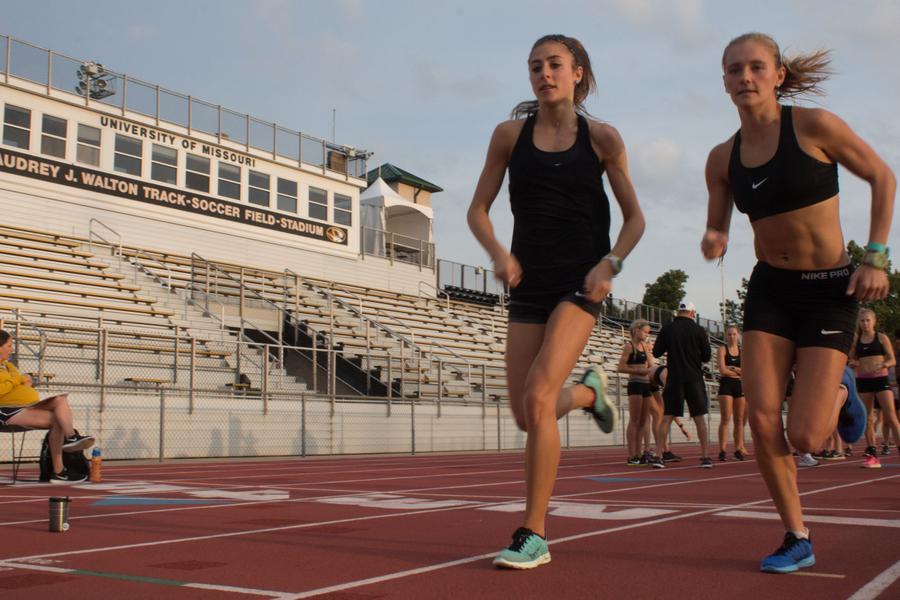
The Missouri women’s cross-country team knows this year is their best shot in three years under coach Marc Burns to earn a berth to the National Championships in November. But aside from exceptional races and staying healthy, there is one thing the team believes will be critical in order to reach that goal: leadership.
With eight redshirt juniors and two seniors on this year’s squad, Burns said he expects his upperclassmen to lead both in practice and at the front of the pack during races.
“You’ve got to have good leadership at the front, and this team has really good leadership at the front,” Burns said. “You can have leaders that aren’t your top runners, but to have a really good team, you need your top runners to be pretty good leaders because they’re the ones leading the charge. They’re the ones holding the flag when you go to fight, go to battle. The leadership on this team is really, really good.”
In years past, the team has had to endure significant injuries to its top runners, including many of the runners who are now redshirt juniors. Senior captain Teylar Adelsberger said leadership will be especially key in order for the team to deal with the aches and pains that come with a grueling cross-country season.
“Leadership will be a really big deal [because it will] make sure that we stay positive and have people reminding everyone that as long as we’re all healthy and ready to go when it matters, that’s what’s most important,” Adelsberger said.
Redshirt junior Kaitlyn Fischer, also a captain, said she feels a big part of being a leader on the team is making sure she and her fellow runners get the medical treatment they need to stay healthy.
“I’m always going to the trainer and encouraging other people to go to the trainer,” she said. “It’s kind of my job or Teylar [Adelsberger’s] job to tell someone if we think they should go to the training room because we’re always in there.”
Adelsberger said she thinks leadership can help to not only prevent injury but also offset it when it inevitably happens.
“Leadership offsets injury in the sense that it helps the people who are injured want to come back that much quicker and do everything they need to do [in order to do so],” she said. “Trusting the process is [also] key; if [the injured runner] knows they have a good leader they’re willing to do everything they can to come back while keeping positive about it.”
Burns said his leadership and coaching style focuses more on having his runners lead the team from within than on him preaching discipline and injury prevention.
“What we try to do on a daily basis is to really talk about development, process, keeping it simple, taking it one day and one thing at a time, things like that,” he said. “And that gets ingrained in them a little bit at a time. [The athletes then] develop, and their maturity level grows every year, and then they start preaching it to the younger kids. It becomes orbital, and then they pass it down, and that’s when good things happen. We’re starting to get there.”
Burns stressed the importance of maintaining consistency as well. He said he focuses on giving the team a message they can stick to.
“Consistency breeds a lot of that leadership, too, because they get more comfortable with our style as coaches, they absorb a lot of what we’re saying on a daily basis, and they can pass it down,” he said.
Adelsberger said the team’s leadership philosophy has changed significantly under Burns.
“Burns enforces leadership by letting us grow as leaders,” she said. “He’s less of a Type A [person] and more of a Type B [person] in that he lets the leaders naturally come out. He runs things, but he’s good about letting people lead on their own.”
Fischer said she’s seen leadership on the team improve significantly since Burns took over as coach, especially during the last two years.
“Within the past two years, people have been stepping up to the plate more and wanting to do the little things and help others be good,” she said. “It’s become more of a collaborative group effort. We all have our strengths and weaknesses and we’re all trying to even each other out.”
Senior Nicole Mello said the dichotomy between individual participation and team scoring is one of the aspects of cross-country that makes it unique from other sports.
“Our sport is so individual, but it’s also so team-oriented all at the same time,” Mello said. “So some days, a senior is going to have a bad workout and a sophomore is going to push them through, or vice-a-versa [where] a senior is a veteran and knows how a workout is going to pan out and is going to help the freshman get through it,” Mello said. “I think it really just depends on the day, but we all help each other out.”
Mello stressed that the best cross-country teams understand the importance of the team over individual performance.
“It’s my fourth year here on the team for cross country and it’s really hit me that we need to be good as a team to get as far as we can and that one person can help everyone [succeed], so one person has a big part on the whole team,” she said.
Overall, Burns said he feels confident in the ability of his upperclassmen to lead the Tigers to nationals and put the program in the position to be successful for years to come.
“These guys are committed to being the best they can be,” he said. “They do everything right. They work hard, they rest, they recover, they do great in school, they do everything that leaders are supposed to do, so now the younger kids have some really good role models to follow.”
_Edited by David Reynolds | [email protected]_